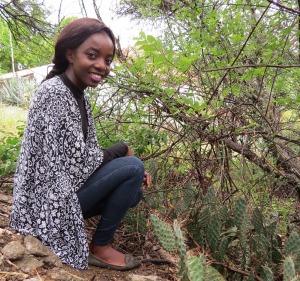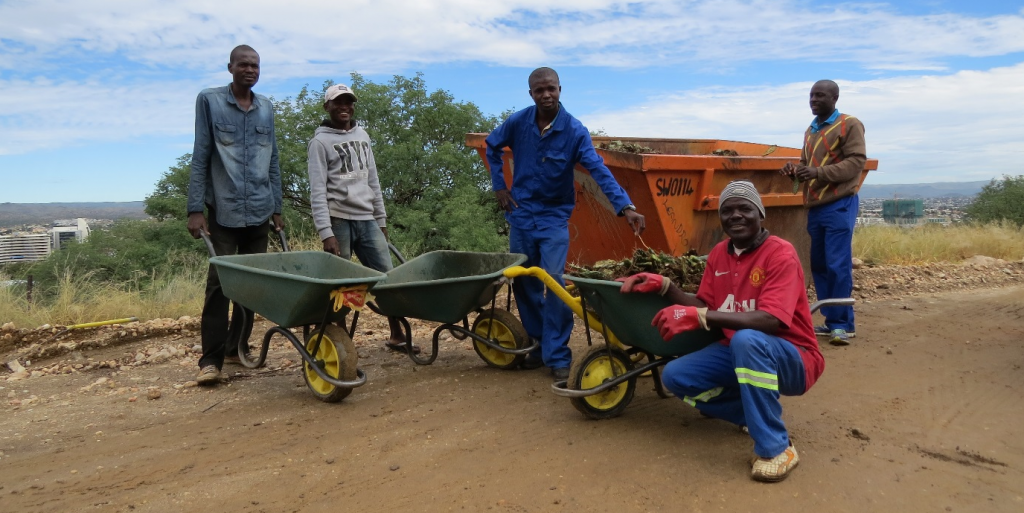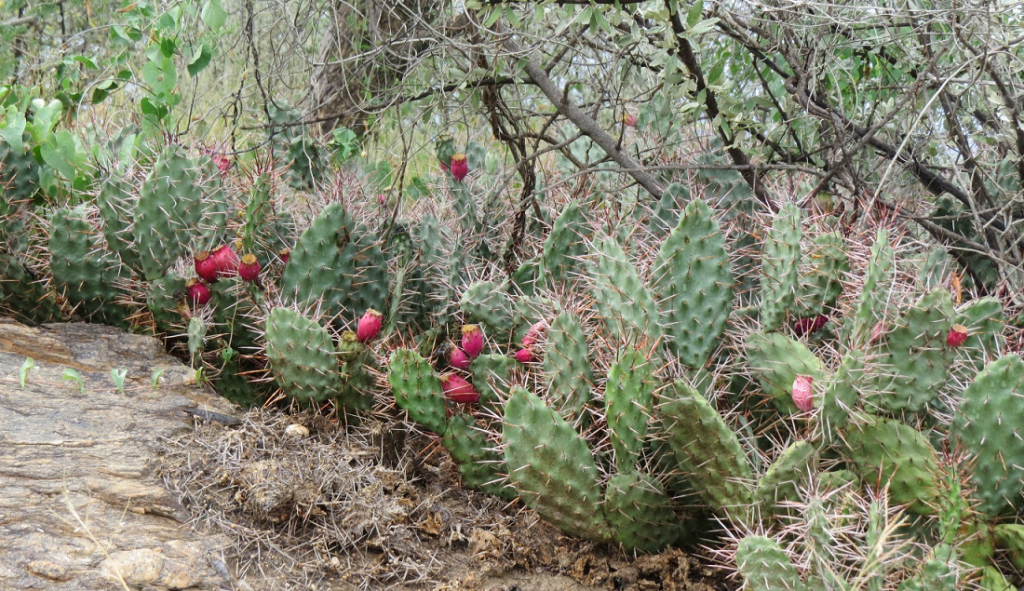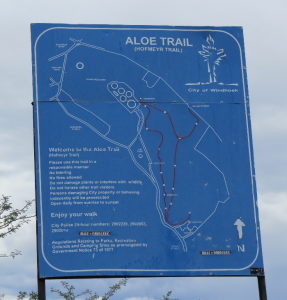Cacti are popular horticultural addition to the arid garden landscape: they require very little water, they are always green, they thrive in hot climates and they are particularly ornamental, especially when in bloom.
However, cacti are predominantly new world species with only one species of cacti (Rhipsalis baccifera) known to naturally occur in the old world (Africa and Asia), according to Novoa et al, 57 of the 1922 cactus species are considered invasive, with 35 of these species growing in South Africa.

The inspiring Rosalia Joseph next to some prickly pears, Opuntia spp., a very common invasive species in Namibia.
Rosalia Joseph is an intern for SASSCAL’s research Task 059 that aims to improve the quality of plant and vegetation databases of the National Botanical Research Institute (NBRI) of Namibia by the implementation of a Botanical Research and Herbarium Management System (BRAHMS) (Principal Investigator: Frances Chase).
Early this year, Rosalia organised an awareness-raising presentation on invasive cacti at NUST (Namibia University of Science and Technology) and then organised her first clean-up in early April, which was supported by NUST and UNAM (University of Namibia) students. (The Namibian, 06 April 2017)
To find out more about future cactus clean-up campaigns and this inspiring young lady who spends her free time raising awareness on invasive species and also supports local waste management campaigns, I met up with Rosalia in Windhoek’s beautiful Botanical Garden at the NBRI.
What was the driver for you to organise the cactus clean-up initiative?
Rosalia explained that she is naturally passionate about our environment and aspires to become an Environmental Manager. She first became involved with a cactus clean-up campaign when she volunteered at a clean-up of the Botanical Society. Further inspired by the initiative of Gunhild Voigts, who is the driving force behind an active cactus clean-up campaign, she decided that the youth of Windhoek should become involved.

An enthusiastic team of workers employed by Gunhild Voigts to clean up prickly pears in one of WIndhoek’s green areas. The skip is provided by the City of Windhoek.
Why is it important to remove these invasive cacti plants?
Cacti are invasive species in the Namibian environment, because they thrive so well in these dry climatic conditions. Cacti have jointed stems, consisting of flattened parts called cladodes. These take on the photosynthetic function. If these cladodes are broken off the plant they are capable of rapidly growing into a new cactus plant. They compete with native succulent and other native species, and thus displace them. Once native species are displaced, their ecosystem role can no longer be performed, which creates gaps in the ecosystem and alters the ecosystem function. In addition, many of the species are entirely inedible to large herbivores due to the presence of impenetrable spines on the cladodes.
Why has the growth of these cacti become such an issue?
For many years, the growth of cacti has remained uncontrolled. Home owners plant cacti because they are fast-growing, drought resistant and popular ornamental plants. Few are aware of the invasive nature of some cacti species. Therefore, it is so important to raise awareness on the danger these invasive species pose.
The good rains in the 2010/11 rainy season may have also encouraged further spreading of the invasive cacti.

Common Prickly Pear Opuntia stricta flourishing amongst native vegetation along one of Windhoek’s hiking trails.
How do the cacti spread and what encourages their growth?
Cacti will spread either vegetatively, where any part of the plant can develop into a new plant, or are spread by birds when they eat the fruit or seed of the plant.
Even though cacti thrive in drought conditions, their growth is also encouraged by rainfall.
When is the best time to remove the cacti, and can the removal of the plant help spread them?
Cacti are best removed during the winter months, as the plant tissue contains less water and is lighter, making removal easier. In addition, in the dry winter months, the cactus plant stands out against the otherwise brown vegetation and is thus easier to find. Younger plants are also easier to remove at this time.
The plants are best removed with steel rakes, garden forks and/or barbecue tongs. It is important to remove the roots and not to leave any piece of the plant behind. If parts of the plants are accidentally left behind, these will create new plants.
A full article will be published in the next SASSCAL Newsletter (June 2017), which will also include information on other invasive plant species.

The next cactus clean-up campaign is organised for 22 April 2017, and starts at 08:00 at the Windhoek Aloe Trail (just off Anderson Street going past the infamous Sugar Cone of Windhoek). A number of UNAM and NUST students have already committed their support and some local businesses will provide refreshments to the hard workers.
Please bring your metal rake or barbecue tongs and come support this fantastic initiative. I will definitely be there!




